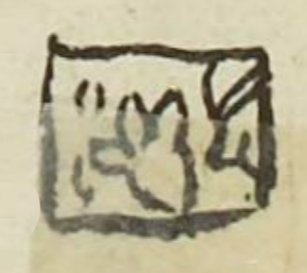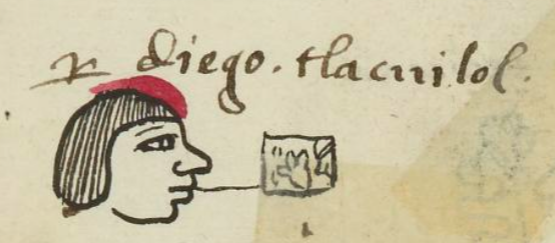Tlacuilol (MH526r)
This black-line drawing of the simplex glyph for the personal name Tlacuilol (short for tlacuilolli, “Painting" or "Document,” attested here as a man’s name) shows what seems to be a frontal view of a square with a flower in the middle. On the viewer's left are three short lines (which might represent writing), and on the right edge there is either an upside-down flower or perhaps a stone, given the diagonal lines.
Stephanie Wood
As other glyphs and their glosses demonstrate, tlacuilolli, cuilolli, icuilolli, and icuiloa can point to an array of types of design expressions that include not only writing and painting on paper but also carvings in stone and the cultivation of the earth. The combination of images in this glyph seem to cover the bases.
Marc Thouvenot identifies the verb icuiloa (or ihcuiloa, with the glottal stop), which means to paint, write, or print, as having a root of -cuil-. He notes how it also appears in tlacuiloliztli (writing), tlacuilo (writer), and cuicuiltic (mottled). He goes on to show various uses of icuiloa that take it beyond the simple definitions just given, resulting in something like the action of creating a design (e.g., on leather, ceramics, sculpture, or in textiles). It can also be something like the action of decorating (e.g., to put a flower on a cup of atole). He associates icuiloa and tlacuilolli with "cultural artifacts," such as arts and crafts or examples of writing and painting, but cuicuiltic with effects created by "nature." This short summary barely does his article justice; it is worth reading the entire piece. How Thouvenot's study might connect with the concept of bent or curved mentioned by Prem (1974: 555, 682) raises an interesting question. Perhaps the bent or curved lines of writing, painting, carving, embroidery, and so on, fall with in the realm of expressions of -cuil-. See
Marc Thouvenot, "Imágenes y escritura entre los nahuas del inicio del XVI," Estudios de Cultural Náhuatl 41 (2010).
Stephanie Wood
diego.tlacuilol
Diego Tlacuilol
Stephanie Wood
1560
Stephanie Wood
writings, escrituras, escrito, tlacuilos

tlacuilol(li), a piece of writing or a painting, https://nahuatl.wired-humanities.org/content/tlacuilolli
La Pintura, o La Escritura
Stephanie Wood
Matrícula de Huexotzinco, folio 526r, World Digital Library, https://www.loc.gov/resource/gdcwdl.wdl_15282/?sp=131&st=image.
This manuscript is hosted by the Library of Congress and the World Digital Library; used here with the Creative Commons, “Attribution-NonCommercial-ShareAlike 3.0 License” (CC-BY-NC-SAq 3.0).



